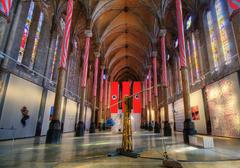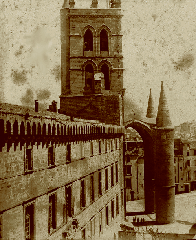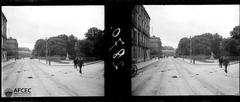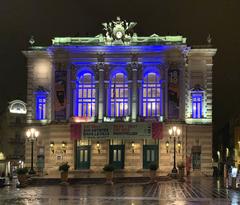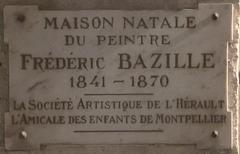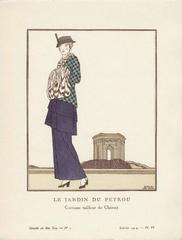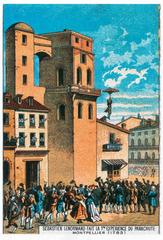Ancienne Maison De La Miséricorde Montpellier: Visiting Hours, Tickets, and Historical Guide
Date: 03/07/2025
Introduction
Nestled in Montpellier’s historic center, the Ancienne Maison De La Miséricorde stands as a testament to centuries of compassion, female-led social initiatives, and the city’s medical and architectural heritage. Established in the early 17th century, this former charitable institution now serves as a museum, offering visitors a window into the intertwined narratives of charity, medicine, architecture, and women’s leadership that shaped Montpellier. This comprehensive guide details the site’s history, architectural features, cultural significance, and provides practical information on visiting hours, ticketing, accessibility, and nearby attractions.
For up-to-date information and special events, consult Montpellier Tourism and the city’s official heritage page (Montpellier.fr).
Table of Contents
- Historical Overview
- Architectural Highlights
- Artistic and Cultural Significance
- Visiting Information
- Accessibility and Visitor Services
- Nearby Attractions
- Visuals and Digital Resources
- Frequently Asked Questions (FAQ)
- Conclusion and Visitor Recommendations
- References and Further Reading
Historical Overview
Origins and Mission
Founded amid the turbulence of the French Wars of Religion, the Ancienne Maison De La Miséricorde was established in 1622 by the Dames de la Miséricorde. Their mission: to offer food, shelter, healthcare, and education to Montpellier’s most vulnerable citizens (Wikipedia). The Filles de la Charité de Saint Vincent de Paul joined in 1668, expanding the institution’s capabilities in nursing and social welfare (Filles de la Charité). The institution received canonical recognition and was closely associated with Marian devotion, reflecting the city’s religious landscape.
Expansion and Evolution
The institution’s growth was catalyzed in 1715 when Anne de Conty d’Argencourt donated her property on rue de la Monnaie, becoming the Maison’s nucleus (Guide Tourisme France). By 1718, a pharmacy (apothicairerie) was installed, later expanding into adjacent buildings. The 18th and 19th centuries saw significant renovations, including the transformation of the former Hôtel des Monnaies into a neoclassical chapel between 1825 and 1830 (Gralon). After the French Revolution, the Maison transitioned into the Bureau de Bienfaisance, maintaining its social mission until 1965 (grandsudinsolite.fr).
Women’s Agency and Leadership
A defining feature of the Maison was its continuous management by women—aristocratic Dames de la Miséricorde and, later, the Filles de la Charité. These women played a pioneering role in social care, influencing public policy and directly improving countless lives (grandsudinsolite.fr). Their leadership is commemorated in the chapel’s artwork and throughout the institution’s legacy.
Architectural Highlights
Exterior Facade
The Maison’s exterior exemplifies restrained classical architecture, with a symmetrical stone facade, minimal ornamentation, and neoclassical elements added in the 19th century. The main entrance, marked by a dignified stone portal and wrought-iron grilles, welcomes visitors into a space that balances utility and solemn beauty (Wikimedia Commons).
Interior Layout
Inside, the building’s plan reflects its charitable mission: large communal halls, dormitories, and a chapel, interspersed with smaller rooms for administration and care. Notable features include vaulted ceilings, thick stone walls for temperature regulation, and strategic use of natural light through courtyards and high windows.
Pharmacy (Apothicairerie)
The pharmacy—Montpellier’s last historical apothecary—hosts two primary rooms: an 18th-century officine and a 19th-century extension. Both are adorned with period woodwork and display an exceptional collection of pharmaceutical ceramics, including “pots de monstre” and “pots canons,” which highlight the region’s faience tradition (Guide Tourisme France).
Chapel
The chapel, converted from the city’s former mint by architect Jacques Nanquette, features neoclassical design, trompe-l’œil masonry, faux marble woodwork, and a tribune gallery. It remains a centerpiece for both aesthetic and spiritual reflection.
Artistic and Cultural Significance
Artistic Treasures
The chapel is home to significant artworks, such as Eugène Devéria’s “La Charité de saint Vincent de Paul” and Auguste Glaize’s “Les Dames de la Miséricorde.” Paintings by Reynaud Levieux and other artists further enrich the site’s narrative. The pharmacy’s collection of over 400 objects provides a unique window into Montpellier’s medical history (Montpellier.fr).
Cultural Impact
For over three centuries, the Maison was central to Montpellier’s social welfare, serving as both a model charity and a center for women’s public agency. Its integrated approach—combining food, shelter, education, and healthcare—anticipated modern social work principles and influenced the development of French social services.
Today, managed by the City of Montpellier, it serves as a museum and cultural venue, hosting exhibitions, guided tours, and educational programs that keep its legacy alive (grandsudinsolite.fr).
Visiting Information
Opening Hours
- Tuesday to Sunday: 10:00 AM – 6:00 PM
- Closed on Mondays and public holidays
- Verify seasonal variations and special openings on the official tourism portal.
Tickets and Admission
- General Admission: €6
- Reduced Rate (students, seniors): €4
- Children under 12: Free
- Guided Tours: Available on weekends and by appointment; booking in advance is recommended
- Purchase tickets on-site or through Montpellier’s official portal
Guided Tours
Guided tours (45–90 minutes) are available in French, with English tours offered during high season or by prior arrangement. Tours provide in-depth insight into the Maison’s medical, architectural, and social history.
Visitor Tips
- Advance booking is advised during peak season (May–September) and for groups.
- Dress respectfully for chapel visits.
- Photography is allowed without flash; professional use requires permission.
- Children and families are welcome; strollers may need to remain at the entrance due to narrow spaces.
Accessibility and Visitor Services
- Wheelchair Access: Partial; main entrance and select areas are accessible, though some historic sections have limited access.
- Restrooms: Accessible facilities available on-site or nearby.
- Assistance: Staff can provide support to those with mobility needs; contact ahead for arrangements.
- Facilities: No café on-site, but numerous dining options are nearby. Gift shops may open during exhibitions.
Nearby Attractions
Enhance your visit by exploring other landmarks within walking distance:
- Place de la Comédie — Montpellier’s vibrant central square
- Cathédrale Saint-Pierre — Imposing Gothic cathedral
- Musée Fabre — Renowned fine arts museum (The Crazy Tourist)
- Promenade du Peyrou — Panoramic 18th-century esplanade
- L’Écusson — The medieval old town’s charming streets
Visuals and Digital Resources
- Photographs: See Wikimedia Commons for high-quality images of the pharmacy, chapel, and artifacts (examples: “Ancienne Maison De La Miséricorde pharmacy ceramic pots,” “Chapel artwork at Ancienne Maison De La Miséricorde Montpellier”).
- Virtual Tours: Available via the Montpellier Tourist Office website.
- Alt Text: All images are optimized for accessibility.
Frequently Asked Questions (FAQ)
Q: What are the Ancienne Maison De La Miséricorde visiting hours?
A: Tuesday–Sunday, 10:00 AM–6:00 PM; closed Mondays and public holidays.
Q: How much are tickets?
A: €6 for adults, €4 reduced rate, children under 12 free.
Q: Is the site wheelchair accessible?
A: Main entrance and some areas are accessible; some historic sections may not be.
Q: Are guided tours available?
A: Yes, in French and English (seasonally or by request); advance booking is recommended.
Q: Can I take photographs inside?
A: Yes, non-flash personal photography is permitted; commercial or professional photography requires permission.
Q: How do I buy tickets?
A: Purchase on-site or through the official tourism website.
Conclusion and Visitor Recommendations
The Ancienne Maison De La Miséricorde offers a profound journey through Montpellier’s history of charity, medicine, architecture, and women’s public roles. Its unique blend of preserved spaces, exceptional artifacts, and evocative art makes it a must-see for history lovers, cultural travelers, and anyone interested in the evolution of social care.
Plan your visit:
- Book tickets in advance, especially during busy periods.
- Consider joining a guided tour for deeper insight.
- Explore neighboring landmarks to enrich your experience.
- Stay updated on special events and hours via Montpellier Tourism.
Embrace the opportunity to connect with centuries of compassion and innovation at one of Montpellier’s most meaningful monuments.
